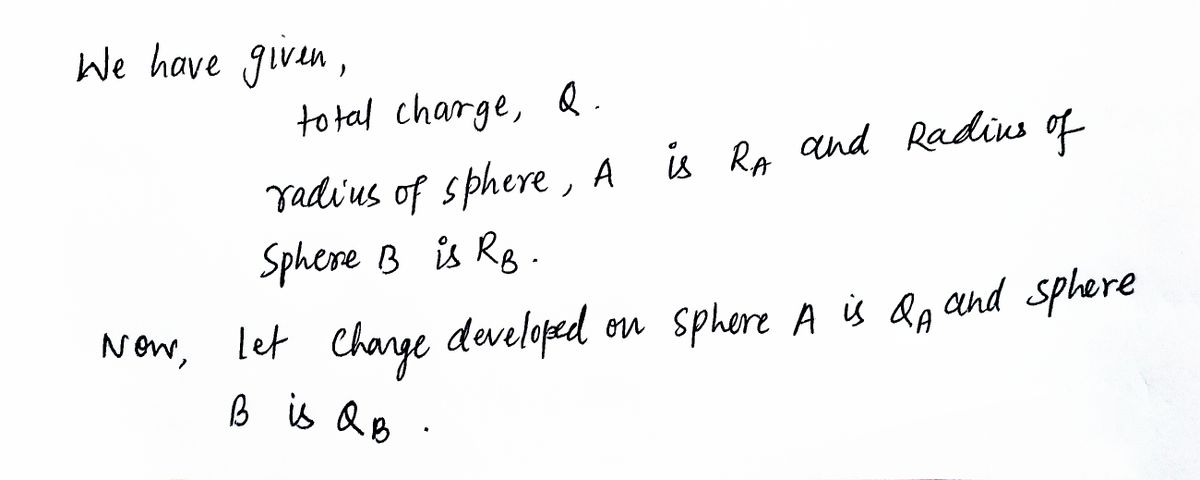Here's a classic problem. Consider two metal spheres of different radiuses Ra and Ra, separated by a great distance. Sphere A has a charge Q and Sphere B is initially uncharged. Now suppose that we run a conducting wire from one to the other, then disconnect and discard the wire. A) Determine the amount of charge on each sphere in terms of the quantities given in the problem. B) Determine the magnitude of the electric field at the surface of each in terms of the quantities given in the problem. HINTS: There may be some information that was not discussed in class. First, the electric field at the surface of a metal is perpendicular to the surface of the metal. If it were not, there would be a component of E along the surface that would force charges to redistribute themselves until that component goes to zero. Second, once charges have stopped moving from A to B, what can you say about their surfaces? Lastly, you may want to consider Gauss's law.
Here's a classic problem. Consider two metal spheres of different radiuses Ra and Ra, separated by a great distance. Sphere A has a charge Q and Sphere B is initially uncharged. Now suppose that we run a conducting wire from one to the other, then disconnect and discard the wire. A) Determine the amount of charge on each sphere in terms of the quantities given in the problem. B) Determine the magnitude of the electric field at the surface of each in terms of the quantities given in the problem. HINTS: There may be some information that was not discussed in class. First, the electric field at the surface of a metal is perpendicular to the surface of the metal. If it were not, there would be a component of E along the surface that would force charges to redistribute themselves until that component goes to zero. Second, once charges have stopped moving from A to B, what can you say about their surfaces? Lastly, you may want to consider Gauss's law.
College Physics
11th Edition
ISBN:9781305952300
Author:Raymond A. Serway, Chris Vuille
Publisher:Raymond A. Serway, Chris Vuille
Chapter1: Units, Trigonometry. And Vectors
Section: Chapter Questions
Problem 1CQ: Estimate the order of magnitude of the length, in meters, of each of the following; (a) a mouse, (b)...
Related questions
Question

Transcribed Image Text:2-3)
Here's a classic problem. Consider two metal spheres of different radiuses RA and Rs, separated
by a great distance. Sphere A has a charge Q and Sphere B is initially uncharged. Now suppose
that we run a conducting wire from one to the other, then disconnect and discard the wire.
A) Determine the amount of charge on each sphere in terms of the quantities given in the
problem.
B) Determine the magnitude of the electric field at the surface of each in terms of the
quantities given in the problem.
HINTS: There may be some information that was not discussed in class. First, the electric field at
the surface of a metal is perpendicular to the surface of the metal. If it were not, there would be
a component of E along the surface that would force charges to redistribute themselves until that
component goes to zero. Second, once charges have stopped moving from A to B, what can you
say about their surfaces? Lastly, you may want to consider Gauss's law.
Expert Solution
Step 1

Step by step
Solved in 3 steps with 3 images

Recommended textbooks for you

College Physics
Physics
ISBN:
9781305952300
Author:
Raymond A. Serway, Chris Vuille
Publisher:
Cengage Learning

University Physics (14th Edition)
Physics
ISBN:
9780133969290
Author:
Hugh D. Young, Roger A. Freedman
Publisher:
PEARSON

Introduction To Quantum Mechanics
Physics
ISBN:
9781107189638
Author:
Griffiths, David J., Schroeter, Darrell F.
Publisher:
Cambridge University Press

College Physics
Physics
ISBN:
9781305952300
Author:
Raymond A. Serway, Chris Vuille
Publisher:
Cengage Learning

University Physics (14th Edition)
Physics
ISBN:
9780133969290
Author:
Hugh D. Young, Roger A. Freedman
Publisher:
PEARSON

Introduction To Quantum Mechanics
Physics
ISBN:
9781107189638
Author:
Griffiths, David J., Schroeter, Darrell F.
Publisher:
Cambridge University Press

Physics for Scientists and Engineers
Physics
ISBN:
9781337553278
Author:
Raymond A. Serway, John W. Jewett
Publisher:
Cengage Learning

Lecture- Tutorials for Introductory Astronomy
Physics
ISBN:
9780321820464
Author:
Edward E. Prather, Tim P. Slater, Jeff P. Adams, Gina Brissenden
Publisher:
Addison-Wesley

College Physics: A Strategic Approach (4th Editio…
Physics
ISBN:
9780134609034
Author:
Randall D. Knight (Professor Emeritus), Brian Jones, Stuart Field
Publisher:
PEARSON